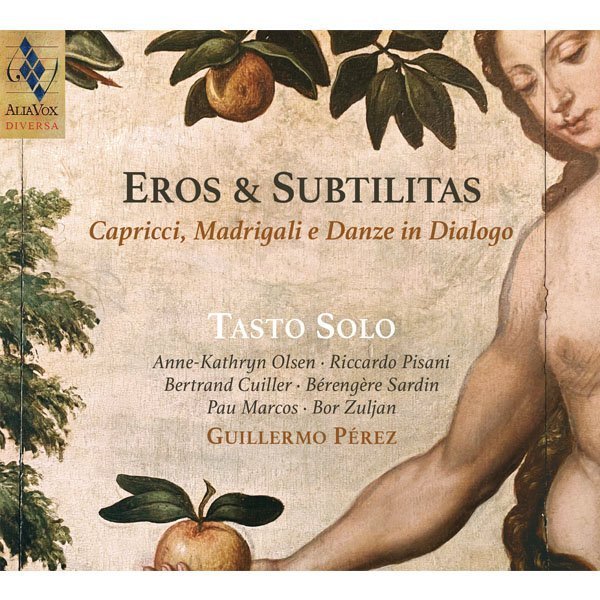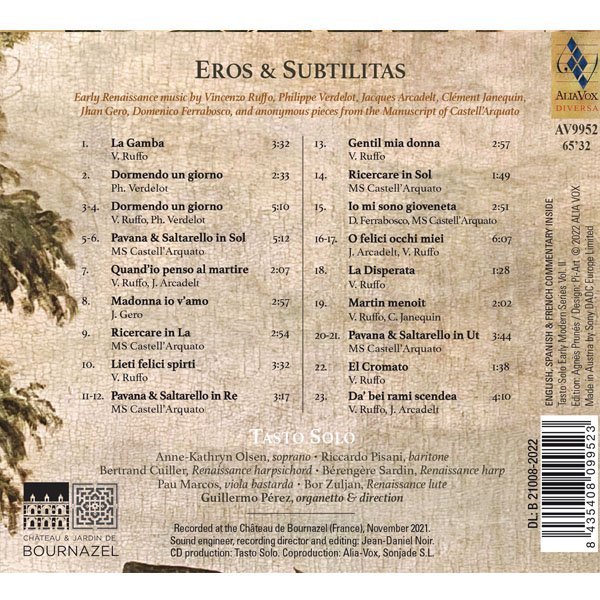EROS & SUBTILITAS
Capricci, Madrigali e Danze in Dialogo
Alia Vox Diversa
17,99€
ALIA VOX DIVERSA
AVSA9952
Total time: 65:32
EROS & SUBTILITAS
Early Renaissance music by Vincenzo Ruffo, Philippe Verdelot,
Jacques Arcadelt, Clement Janequin, Jhan Gero, Domenico Ferrabosco,
and anonymous pieces from the Manuscript of Castell’Arquato.
1. La Gamba 3:32
V. Ruffo
2. Dormendo un giorno 2:33
Ph. Verdelot
3-4. Dormendo un giorno 5:10
V. Ruffo, Ph. Verdelot
5. Pavana in Sol 2:31
MS Castell’Arquato
6. Saltarello in Sol 2:41
MS Castell’Arquato
7. Quand’io penso al martire 2:07
V. Ruffo, J. Arcadelt
8. Madonna io v’amo 2:57
J. Gero
9. Ricercare in La 2:54
MS Castell’Arquato
10. Lieti felici spirti 3:32
V. Ruffo
11-12. Pavana & Saltarello in Re 3:17
MS Castell’Arquato
13. Gentil mia donna 2:57
V. Ruffo
14. Ricercare in Sol 1:49
MS Castell’Arquato
15. Io mi sono gioveneta 2:51
D. Ferrabosco, MS Castell’Arquato
16-17. O felici occhi miei 6:07
J. Arcadelt, V. Ruffo
18. La Disperata 1:28
V. Ruffo
19. Martin menoit 2:02
V. Ruffo, C. Janequin
20-21. Pavana & Saltarello in Ut 3:44
MS Castell’Arquato
22. El Cromato 1:38
V. Ruffo
23. Da bei rami scendea 4:10
V. Ruffo, J. Arcadelt
TASTO SOLO
Anne-Kathryn Olsen, soprano · Riccardo Pisani, baritone
Bertrand Cuiller, Renaissance harpsichord · Bérengère Sardin, Renaissance harp
Pau Marcos, viola bastarda · Bor Zuljan, Renaissance lute
Guillermo Pérez, organetto & direction
Recorded at the Château de Bournazel (France), November 2021.
CD production: Tasto Solo. Coproduction: Alia-Vox, Sonjade S.L.
Sound engineer, recording director and editing: Jean-Daniel Noir.
English, Spanish & French commentary inside.
–
EROS & SUBTILITAS
Thinking how much music flourishes in our
times, not only that which consists of vocal
harmony, but that of instruments…
Diego Ortiz, 1553
The human voice is consistently praised in the treatises of the Renaissance as the “superior” and “worthy” model that musical instruments should strive to imitate; yet this is perhaps the result of a consensus that was more academic than practical. Indeed, the current revival of historical music has shown that the reconstruction of original instruments and the rediscovery of their playing techniques is a major path to understanding ancient repertoire, whether it is played or sung. Instruments and voices are, in short, part of an ongoing dialogue of a past universe, from which today only the traces of certain stars and firmaments can be seen.
The music of 16th century Europe formed one of the richest constellations, where there was a frenetic arrival of novel works and methods devoted exclusively to the development of the language and practice of instruments in parallel with the vocal arts. Italy was particularly fertile ground, cradling the development of the virtuoso praxis of glosa or diminuzione; the compositional exploration based on fantasia called ricercare; and the diffusion of an endless number of compositions derived from the world of dance. It was also in Italy that we find the first documented use of the term capriccio to name an instrumental composition, giving way to the Capricci in Musica a Tre Voci by Vincenzo Ruffo.
+ informazioni nel libretto del CD
GUILLERMO PÉREZ
Critici
”
La Glosa es un ingrediente esencial del Renacimiento. El “Subtilitas” del título tiene que ver sobre todo con la sutileza de las líneas que el grupo ha articulado para interpretar estos Caprichos que, desde el punto de vista rítmico y melódico, son muy particulares.
DIARIO DE SEVILLA, 29 enero, 2023.
Pablo J. Vayón.
”
Eros & subtilitas deed ons zuchten van verlichting: ook ditmaal is het prijs. Met een dialoog tussen instrumentale en vocale polyfonie van onder meer Ruffo, Arcadelt en Verdelot doen de musici met andere oren luisteren naar de Italiaanse renaissance. De stuk voor stuk uitmuntende uitvoerders maken die premisse waar met geraffineerde madrigalen, overrompelende dansen en bezwerende capriccio’s. *****
De STANDAARD.BE, 1 februari 2023 (PDF)
”
Kto poznał zespół Tasto Solo, ten zdążył się przyzwyczaić do ich wstrzemięźliwości fonograficznej. Jakość, a nie ilość! – oto manifest artystyczny ansamblu. Wyrazista rytmika, sprężyste, lekkie, delikatnie zadziorne i obdarzone indywidualnością interpretacje są zachwycające. Bardzo mi się podoba ta płyta i każdy następny album Tasto Solo będę witał z radością.
Anyone who has met the Tasto Solo is accustomed to their phonographic restraint. Quality, not quantity! – this is the artistic manifesto of the ensemble. At last we have their latest album. The expressive rhythmics, the bouncy, light, gently feisty and individually gifted interpretations are delightful. I like this album very much and will welcome further Tasto Solo album.
RM KULTURA INY SPOSOB - Robert Majewski
RECORD OF THE WEEK
10 lutego, 2023
”
La sonorité particulière de l’ensemble Tasto Solo apporte une fraîcheur et élan d’une poésie revigorante à cette combinaison de pavanes, de caprices, de romanesca, de saltarello et autres passamezzo.
MUSIKZEN. Franck Mallet
23 février 2023
”
The effect of this sequence of variations and musical dialogues is strangely mesmerising.
GRAMOPHONE, February 2023
”
El conjunt Tasto Solo presenta "Eros & Subtilitas.
Un nou àlbum del conjunt Tasto Solo, que dirigeix el seu fundador, el teclista català Guillermo Pérez. El seu títol complet és "Eros & Subtilistas: Capricci, Madrigali e Danze in Dialogo", i està integrat per música instrumental i vocal del renaixement italià de Vincenzo Ruffo i dels seus contemporanis. L'àlbum l'ha editat el segell Alia Vox."
CATALUNYA RADIO, 27.02.2023
”
On admire l’osmose parfaite de l’ensemble
DIAPASON MAGAZINE, March 2023
****
”
Que dire d’un tel disque ? Tout y est parfait
HARMPESMAG (France), Mars 2023
”
Un enregistrament d’una immensa significació musical i d’una refinada direcció que compta amb músics, instrumentistes i cantants d’un meravellós nivell interpretatiu.
SONOGRAMA, març 2023. Núria Serra
”
Les deux solistes vocaux s’intègrent à cet écheveau qu’on admire pour son intelligence et qui grise par son envoûtant tramage. Les recettes ne sont pas neuves, mais la concrétisation fascine, courtisant incessamment l’oreille par ses timbres chatoyants et ses textures à fleur de peau. (no se si ho posem en majúscula)
BARROQUIADES, 14 juin 2023. Christophe Steyne
”
Els 10 millors discos de clàssica del 2023. La crítica configura una llista amb els deu treballs catalans de música clàssica més destacats de l'any 2023.
440Clàssica&Jazz. 05/02/2024








Compartir